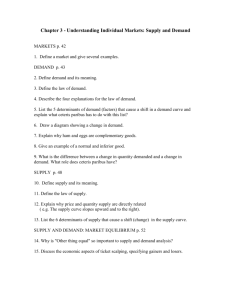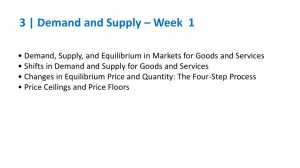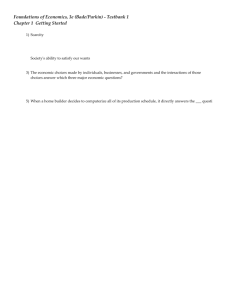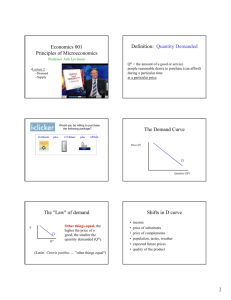How Markets
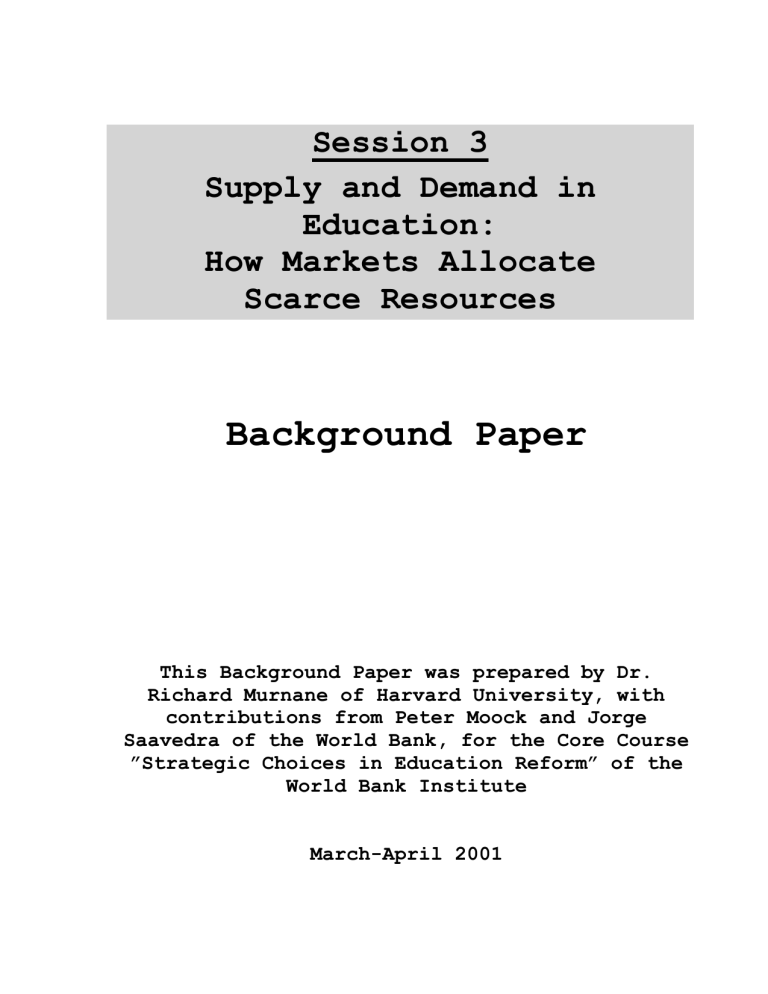
Session 3
Supply and Demand in
Education:
How Markets Allocate
Scarce Resources
Background Paper
This Background Paper was prepared by Dr.
Richard Murnane of Harvard University, with contributions from Peter Moock and Jorge
Saavedra of the World Bank, for the Core Course
”Strategic Choices in Education Reform” of the
World Bank Institute
March-April 2001
Economics and Financing of Education Supply and Demand in Education
Supply and Demand in Education: How Markets Allocate Scarce Resources
" At all times and places, that is dear which it is difficult to come at, or which it costs much labour to acquire; and that cheap which is to be had easily, or with very little labour ."
-Adam Smith
Introduction
In the country of Xylos, university education is highly prized. Graduates of the university system have earnings 80 percent higher on average than those of workers who are not university graduates. All universities in the country are publicly funded. There is no tuition. Indeed, students receive living subsidies from the government. Currently the 1,000 new places available each year in the country's university system are awarded to the 1,000 students who receive the highest scores on the national university entrance examination. Last year 9,000 students took the examinations. While this imbalance between supply of places (i.e., 1,000) in the university system and the demand for these places (i.e., 9,000) has prevailed for many years, the recently elected democratic government in Xylos is committed to change.
This session is devoted to developing tools that are helpful in considering options for tackling this and similar problems. (The exercise that you will tackle at the end of the class session deals with the policy problem in Xylos.) As usual, we must begin by developing an analytical framework. Thus, this session begins by describing the mechanisms that determine how prices and quantities are set in competitive markets (see definition of a competitive market below).
Although the treatment is somewhat abstract, the basic lessons are helpful in understanding a variety of educational policy issues.
Most of the microeconomic tools you will learn today were developed by the English economist,
Alfred Marshall (and are described in his 1890 text, Principles of Economics ). Economists call these tools “supply and demand analysis (although Marshall himself called them comparative statics). Keep in mind that Marshall developed the tools of microeconomics not as an intellectual game, but rather because he saw them as valuable in understanding critical issues related to how well a society worked.
Supply and demand analysis examines the effect of a single change, holding constant the other factors that affect demand and supply (the ceteris paribus assumption)
in a given market.
While simple in its design, Marshall's framework is useful in analyzing the consequences of a variety of events. Supply and demand analysis is, seen from one perspective, very mechanical:
A particular market, say the market for private secondary school education, starts off in equilibrium, meaning that at the market price, demand equals supply. Then, some event results
1
Ceteris paribus is Latin expression for “all other things being equal.” In other words, by keeping other factors unchanged or "other things equal," the analysis focuses on the effects or consequences of changes in only one variable at a time. For example, “an increase in the fees charged by secondary schools in Xenox will, ceteris paribus , reduce the number of students who want to enroll in secondary school in Xenox.”
2
The Marshallian framework is called "partial equilibrium analysis," because it does not take into account how changes in one market affect prices and quantities in other markets
1
Economics and Financing of Education Supply and Demand in Education in a shift of the demand curve or the supply curve. By figuring out which curve shifts, and in which direction, you can figure out how the event will affect the equilibrium quantity and the equilibrium price.
Competitive Markets
A market for a given good or service (e.g., private primary education) is said to be competitive if there is a sufficient number of independent buyers (i.e., families) and sellers (i.e., private primary schools) so that no individual buyer or seller can determine or influence the price of the good or service (i.e., the fees charged by private schools) on his/her own, that is, by buying or selling large number of units of the good or service. In other words, the price in a competitive market is the unintended result of the free exchanges that take place in that market between buyers and sellers of the good or service.
More rigorously, our definition of a competitive market is one in which the following assumptions are fulfilled:
Assumption 1: Output is homogeneous; there are no quality differences in the output provided by different producers.
Assumption 2: All consumers can purchase all of the commodity they want at the given market price, but no consumer can individually influence the market price.
Assumption 3: All producers can sell all of the output they care to produce at the given market price, but they cannot sell any output at a price above the market price.
There are no markets for educational services in which all of these assumptions are satisfied.
Nonetheless, understanding how prices and quantities are determined in competitive markets provides valuable insights into the operation of markets for a variety of educational services.
Thus, following our introduction to supply and demand analysis tools, we will assume the existence of a competitive market for private primary education in Xenox.
Supply and Demand
At a mechanical level, it can be said that the market clearing price is determined by the interaction of demand and supply. The market clearing price is that price at which the total number of units demanded equals the total number of units supplied (e.g., the level of school fees at which the supply of school places equals the demand for primary education). However, to understand this abstract statement, it is necessary to look separately at the determinants of the quantity demanded and the quantity supplied. Let us turn first to analyze demand.
Determinants of Demand
Consider the market for primary school education in the country of Xenox. In this fictional country, there is no variation in the quality of primary schools, nor are any schools more conveniently located than others. (In other words, the schools fit assumption 1 of a competitive market.) All primary schools are privately owned and operated and can offer as many school places as they want at the given market price (assumption 3). Families send their children to
2
Economics and Financing of Education Supply and Demand in Education school only if they can pay the bill and if they view it as worthwhile (assumption 3). (To keep the example simple, assume that every family has one child and that this child is of the age to attend primary school.)
Question: Under these circumstances, how many families will desire a primary school place for their child?
The demand for places in primary school (represented by the symbol Q
D
or ‘quantity demanded’ or ‘number of primary school places demanded by families’) will depend on a number of factors, including:
(a) The price schools charge (P i
). All other things being equal, the higher the price schools charge in Xenox, the lower the demand for primary school places in Xenox.
(b) The prices of other goods and services that are complements to private primary school education (P j
, j = 1, 2, . . . n). The higher the price of complements, the lower the demand for primary school places. Examples of complements to primary school education might be uniforms, if secondary schools require uniforms, or meals and transportation.
(c) The prices of other goods and services that are substitutes for private primary school education (P j
, j = 1, 2, . . . n). The higher the price of substitutes in Xenox, the lower the demand for primary school places in that country. Examples of substitutes for secondary school education might be apprenticeships, if craftsmen in the country charge families a particular fee for providing apprenticeships to older primary school students.
(d) The opportunity cost of children's time (OC)—i.e., the value of the child's time if the child were to work instead of going to school. The higher the opportunity cost of children’s time, the lower the demand for primary school places.
(e) The number of families in the country (Pop). Assuming that all families have one child of primary school age, then the greater the number of families in a country, the higher the demand for primary school places.
(f) The distribution of income among the families in the country. Often the income distribution is summarized by the average income, call it Y*, but, of course, it is really the whole distribution that matters. The higher the average income, the higher the demand for primary school places.
Economists normally describe the demand as:
Q i
D
= f(P i
, P j
, OC, Pop, Y* )
All this means is that the quantity of good i demanded depends on (i.e., is a function of) the price of good i, the prices of complements to and substitutes for good i, the opportunity cost of children's time, the size of the population, and the distribution of family incomes in the country.
Holding constant population, the distribution of income, the opportunity cost of children's time, and the prices of complements to good i and substitutes for good i, we would expect that more families would want to send a child to private school if the price were lower—i.e., ceteris
3

